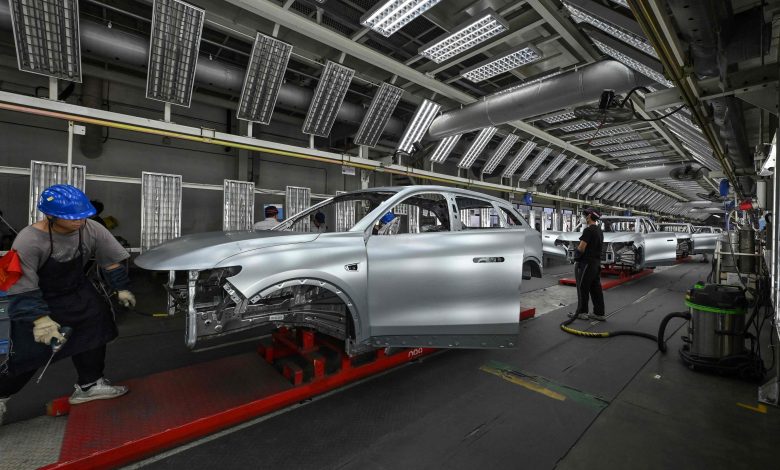Electric vehicle sales are stumbling. Here’s why

WITH road transportation accounting for about 15 per cent of greenhouse gas emissions, it’s hard to see how the world will reach its net-zero climate goals unless people give up their petrol and diesel cars.
For many years, governments offered generous subsidies to encourage drivers to switch to electric vehicles (EVs). As prices fell and the technology improved, zero-emission cars went from niche to mainstream. Carmakers began to retool factories and offer a wider selection of EVs to meet the demand. Prices fell closer to those of fossil-fuel-powered cars, and it began to look as though the combustion-engine era may be over sooner than expected.
This year, the EV transition is having a wobble. Governments are scaling back financial incentives for EV buyers, sales growth is stalling and the auto industry is having second thoughts about some of the investment plans that were predicated on a rapid shift to electric. What’s gone wrong?
What’s happened to EV demand?
Although China continues to post healthy growth, demand in Europe and North America has been softening. According to BloombergNEF, sales of all-electric vehicles plus plug-in hybrids that can also be powered by petrol or diesel more than doubled in 2021 and grew 62 per cent in 2022. But growth slowed to 31 per cent last year. China was the main driver, accounting for 59 per cent of global sales, excluding commercial vehicles.
In Europe and the US, the shift to EVs effectively went into reverse, as cars with exhaust pipes took a growing share of overall sales. The market share of battery cars in Europe shrank to 14 per cent in August from just over 15 per cent a year earlier. In Germany, the continent’s biggest market, EV sales plunged by 69 per cent. Automotive researcher JD Power forecast that battery-powered models will account for 9 per cent of sales in the US this year, down from a previous estimate of 12.4 per cent.
Some carmakers in Europe are now warning they could incur billions of euros in fines if they can’t meet the European Union’s ambitious climate goals due to falling EV sales.
BT in your inbox

Start and end each day with the latest news stories and analyses delivered straight to your inbox.
What’s causing the slowdown?
For the first wave of EVs, carmakers were able to offer drivers the allure of being an early adopter, loading the vehicles with tech gadgets and functions to boost their cachet.
The drivers they needed to win over next were more cost-conscious. They were also more likely to be sceptical of the technology, and wary of buying an EV when they weren’t sure they could find somewhere to recharge it en route. That’s especially the case in the US, where EV charging locations are clustered in cities and along the East and West coasts.
In Europe, the drop in sales has coincided with the removal of government subsidies. Without those, EVs are still proving too expensive compared with equivalent fuel-burning cars. On average, all-electric vehicles are 30 per cent and 27 per cent pricier in Europe and the US, respectively. There are cheaper EVs out there, namely in China. But governments in Europe and the US are protecting their domestic car manufacturers with tariffs and other barriers to keep Chinese EV makers such as BYD at bay.
What does the slowdown mean for the industry?
Several manufacturers, including GM, Ford, Mercedes-Benz, Volvo and Toyota, have now softened their EV ambitions.
Together, the legacy carmakers – those with a long history of making combustion-engine vehicles – are targeting 23.7 million EV sales in 2030, more than three million units fewer than they had forecast last year, according to BloombergNEF.
Even Tesla, the pure-play EV maker that did much to make EVs a hit with drivers, has stopped referring to its goal of delivering 20 million units a year by 2030.
In the US, Ford is scrapping an all-electric three-row SUV and postponing a next-generation pickup, cutting its spending on EVs to 30 per cent of its annual capital expenditure from about 40 per cent previously.
Chinese producers have gained an upper hand in EV technology and are overtaking European brands in China, the world’s biggest EV market. They’ve also been making inroads in Europe where, until relatively recently, they had little presence.
What’s at stake?
The transition to EVs is a pillar of global ambitions to curb climate change. It’s also a major challenge for an auto industry that’s critical to many economies.
Auto manufacturers employ hundreds of thousands of people, as do suppliers such as battery makers that are being hit by the slowdown. Northvolt, Europe’s most promising battery producer, is shedding 20 per cent of its global workforce and has paused expansion plans due to slowing demand.
The global push to electrify road transportation has left European and US carmakers facing a major competitive threat from China, which took an early lead in EV technology.
Western governments now face a dilemma: Opening the door to more imports and manufacturing of Chinese EVs and EV parts would help to keep prices falling in Europe and North America and spur demand. But it could also undermine local manufacturers and further entrench China’s dominance in the clean industries of the future.
For now, governments on both sides of the Atlantic are imposing additional import barriers to protect their emerging clean-technology industries from Chinese competition.
China’s pricing advantage is striking: The cost of batteries there has dropped to US$126 per kilowatt-hour on a volume-weighted average basis, while packs are priced 11 per cent higher in the US and 20 per cent higher in Europe, according to BloombergNEF. In the meantime, Chinese manufacturers are already unveiling a new generation of batteries that rely on sodium, which is more abundant than the lithium now used in EV batteries, and less prone to catching fire.
Is there relief in sight?
Perhaps. Some governments, alarmed by the recent downturn in EV demand, are weighing whether to restore their financial incentives for buyers.
And all the work carmakers have done reconfiguring their factories to make EVs means they are getting closer to offering a wider selection of more affordable models to entice wavering buyers. In Europe, seven new electric models costing less than 25,000 euros (S$35,740) could hit the market this year and next, including a new Renault 5 and Stellantis NV’s Citroen e-C3, according to the Transport & Environment lobby group.
In that optimistic scenario, EVs could grab as much as 24 per cent of the European market next year, according to T&E, which advocates for clean transport and energy. That would be a big leap from the 12.5 per cent market share for EVs in EU countries over the first seven months of 2024, as measured by the European Automobile Manufacturers’ Association. BLOOMBERG





